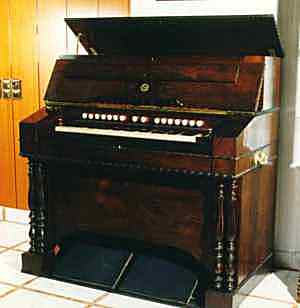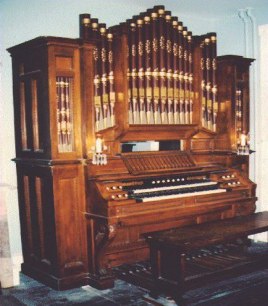Pipe Organ 101 (sort of) | Our Philosophy of Organ Tuning | The Physics of the Organ | How an Organ is tuned | Harmoniums and Reed Organs | Carillons | Harpsichords
 |
 |
In c. 1905 you could have bought one from the "Sears Wish Book" for twenty-five dollars or less - about a fifth the price of a good, new "upright grand". And for a very brief while, it seemed as if these instruments would over take the piano in popularity for domestic use.
The instrument in question is the harmonium - commonly called the "parlor organ" or "pump organ". A direct decedent of European "regals" and "reed positives", the harmonium in its "present" form was perfected in France in the early to middle 19th century. There is some dispute over the date of manufacture of the first harmoniums in the United States, but the middle of the 1800's or just before is close enough to give us an idea of the time period. A few companies manufactured harmoniums up until the 1950's, and the very first electronic organs were harmoniums with electronically amplified reeds.
A related instrument - the somewhat simpler "Melodeon" was manufactured in America a few decades before French style harmoniums. Melodeons are considerably rarer than harmoniums and therefore draw a far higher market price.
The typical harmonium has four ranks of "free reeds". A free reed is simply a reed that sits in a resonating chamber - almost identical in principle to the reeds of a harmonica. The four ranks of reeds are then utilized to produce usually eight speaking stops. Some "deluxe" harmoniums had more than four ranks of reeds, but that is fairly rare. The names of harmonium stops are often fanciful adaptations of the names of pipe organ stops.
A typical American Harmonium has a five-octave compass, beginning with FFF - the F below the lowest C on a modern pipe organ keyboard.
The ranks of reeds are so arranged that different stops be utilized in the "bottom half" and "top half" of the keyboard, allowing a skilled player to emulate the effect of a two manual organ.
The instrument is "winded" by a two foot-pumped "feeder bellows" which "fed" a wind reservoir. It is interesting to note that unlike the pipe organ, the harmonium works on "negative wind pressure". That is to say, the so-called feeder bellows do not put air into the reservoir, but rather pull air out of it, creating a vacuum. When a key is played, a "valve" is opened that allows air, rushing to fill the vacuum to pass across the free reed, therefore causing it to sound.
Much like the fine furniture of the period in which they were constructed the "classic" American reed organ is typically elaborately carved and decorated.
The harmonium is remarkable as an instrument for a number of reasons.
Firstly, the action is so simple that barring absolute abusive handling, little ever goes wrong. When we restore harmoniums what we find is that most of our work is in cleaning out an accumulation of dust, and re-leathering the bellows and reservoir, and refinishing the cabinetry. The action seldom needs much serious adjustment.
Secondly, the tuning of these instruments is uncommonly stable. That is a statement that must be properly qualified. It is difficult to get a harmonium to sound "exactly" in tune - although we will attest that it CAN be done! Truth is known the slight "out of tune-ness" adds to the characteristic charm of the instrument. Conversely, well-manufactured free reeds, which are by the way constructed of brass, will remain in tune for many, many years. It is not uncommon for us to come across an heirloom harmonium whose owners simply look at us askance when we ask about the last tuning, "Tuning? You mean it has to be tuned?"
Well sometimes. But not that often!
Harmoniums are a subset of the larger group of instruments called reed organs. Besides the very popular and still plentiful harmoniums, American industry also produced two and three manual and pedal read organs. The finer ones often had many ranks of reeds... sometimes one rank per stop. A few smaller churches in our acquaintance still utilize these types of organs for services.
French late Romantic composers especially thought highly of the reed organ. The great Marcel Dupre's personal practice instrument was a two manual and pedal reed organ, and much of his organ music sounds well when played on the reed organ.
Universal Restorations is committed to the rescue and placement of these wonderful, long-lived and eminently practical instruments. As such we have a substantial collection of restored and unrestored reed organs of all types available for purchase at very reasonable prices. We also make our services available to owners of these organs considering complete restoration of their instrument, or other maintenance work.
We welcome your questions regarding harmoniums, reed organs or other musical issues.
Renowned American manufacturers of reed organs include:
Mason & Hamlin
Story & Clark
Estey Organ Co.
Hamilton Organ Co.
Fort Wayne Organ Co.
|
About Us | The Mandeville Organ | The Morey Organ | The Never Ending Project | The Essex Chapel Project | Anything Can Be Fixed | Products And Services | Links | Contact Us | Guest Book